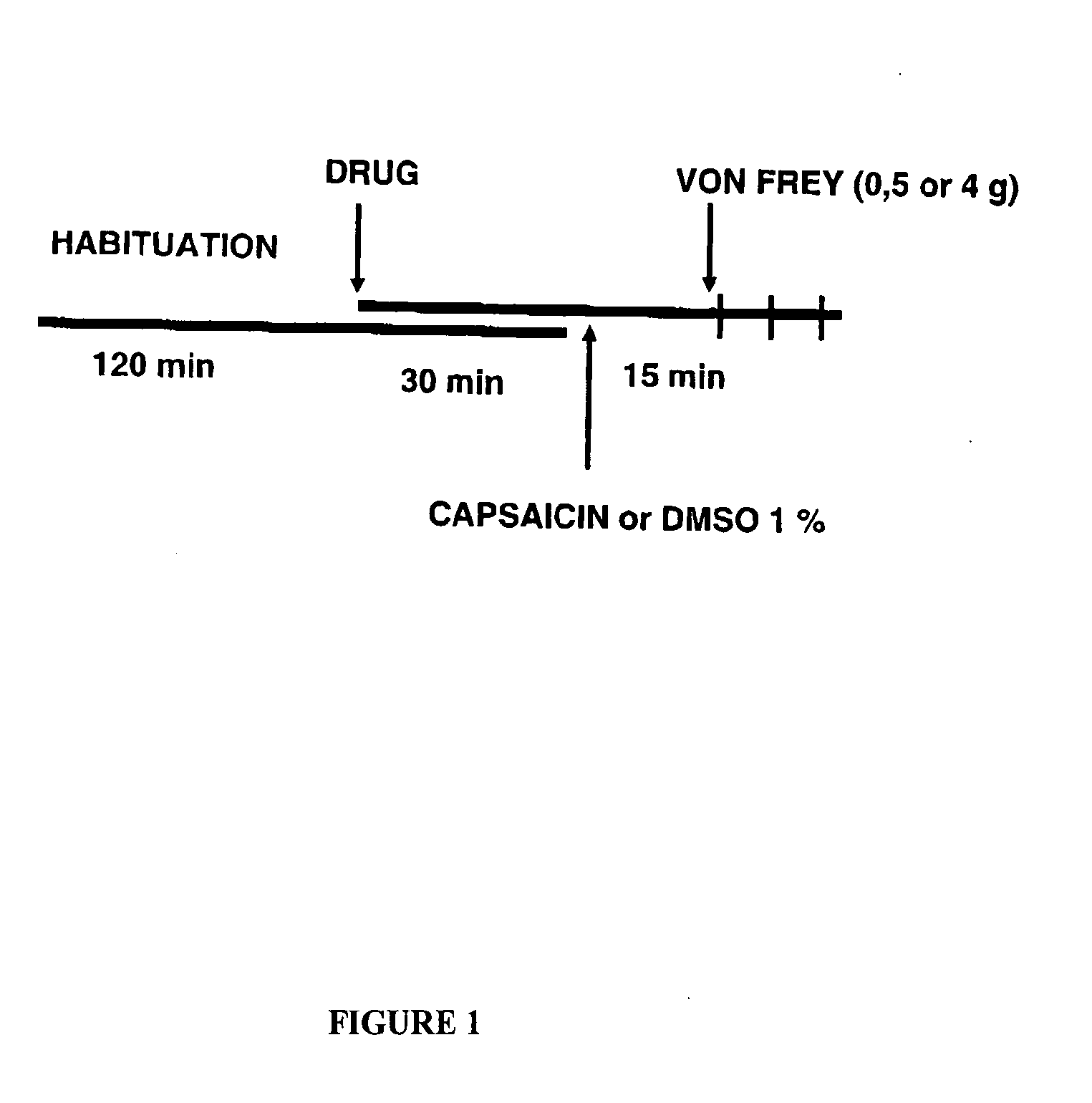Sigma receptor inhibitors
a technology of sigma receptor and inhibitor, which is applied in the direction of metabolism disorder, nervous disorder, organic active ingredients, etc., can solve the problems of compounds on the sigma receptor
- Summary
- Abstract
- Description
- Claims
- Application Information
AI Technical Summary
Benefits of technology
Problems solved by technology
Method used
Image
Examples
example 1
Synthesis of 4-{2-(1-(3,4-Dichlorophenyl)-5-methyl-1H pyrazol-3-yloxy)ethyl}morpholine (VII)
Step 1: Synthesis of Acetic Acid N′-(3,4-Dichlorophenyl)hydrazide (V)
[0094]
[0095]N′-(3,4-Dichlorophenyl)hydrazine was liberated from its hydrochloride (10.0 g, 46.8 mmol) by partitioning the solid between diluted Na2CO3 solution (10 ml saturated solution and 40 ml water) and AcOEt. The aqueous layer was extracted two more times with AcOEt, the organic extracts were dried (Na2SO4), the solvent was removed in vacuo, and the residue was taken up in dry toluene (100 ml). To this solution acetic anhydride (4.78 g, 46.8 mmol) was slowly added, and the reaction mixture was stirred at room temperature for 15 min. Light petroleum (50 ml) was added, the mixture was cooled in the refrigerator (−20° C.), and the resulting crystals were collected on a sintered glass funnel and washed with cold petrol ether. Recrystallization from MeOH yielded (V) (8.30 g, 81%) as shiny white crystals, mp 179-182° C. (lit....
example 2
[0111]The compound VII obtained in example 1 was tested in vitro in a sigma-1 and sigma-2 receptor screening test.
Sigma-1
[0112]Brain membrane preparation and binding assays for the σ1-receptor were performed as described (DeHaven-Hudkins et al., 1992) with some modifications. In brief, guinea pig brains were homogenized in 10 vols. (w / v) of Tris-HCl 50 mM 0.32 M sucrose, pH 7.4, with a Kinematica Polytron PT 3000 at 15000 r.p.m. for 30 s. The homogenate was centrifuged at 1000 g for 10 min at 4° C. and the supernatants collected and centrifuged again at 48000 g for 15 min at 4° C. The pellet was resuspended in 10 volumes of Tris-HCl buffer (50 mM, pH 7.4), incubated at 37° C. for 30 min, and centrifuged at 48000 g for 20 min at 4° C. Following this, the pellet was resuspended in fresh Tris-HCl buffer (50 mM, pH 7.4) and stored on ice until use.
[0113]Each assay tube contained 10 μL of [3H](+)-pentazocine (final concentration of 0.5 nM), 900 μL of the tissue suspension to a final assa...
example 3
Von Frey-Model
[0122]The von Frey model is a model for neuropathic pain especially hyperalgesia / allodynia, stimulated mechanically.
Interest of the Model:
[0123]The injection of capsaicin to experimental animals produces acute pain followed by hyperalgesia / allodynia[0124]The mechanisms involved in capsaicin-induced acute pain and hyperalgesia are relatively well known (mainly activation of peripheral nociceptors and sensitization of spinal cord neurons, respectively)
FIG. 1) shows the test protocol for all tests with von Frey filaments. After habituation mice were according to FIG. 1 first treated with the test-compound (or not in controls). Then capsaicin (1% DMSO) is injected into their paw resulting in developing pain in the effecte paw. The effected paw is then treated with a mechanical stimulus and the latency time before the paw is withdrawn is measured.
[0125]This pharmacological test showed the effect of compound VI in the von-Frey model described, a model of neuropathic pain.
[01...
PUM
 Login to View More
Login to View More Abstract
Description
Claims
Application Information
 Login to View More
Login to View More - R&D
- Intellectual Property
- Life Sciences
- Materials
- Tech Scout
- Unparalleled Data Quality
- Higher Quality Content
- 60% Fewer Hallucinations
Browse by: Latest US Patents, China's latest patents, Technical Efficacy Thesaurus, Application Domain, Technology Topic, Popular Technical Reports.
© 2025 PatSnap. All rights reserved.Legal|Privacy policy|Modern Slavery Act Transparency Statement|Sitemap|About US| Contact US: help@patsnap.com



